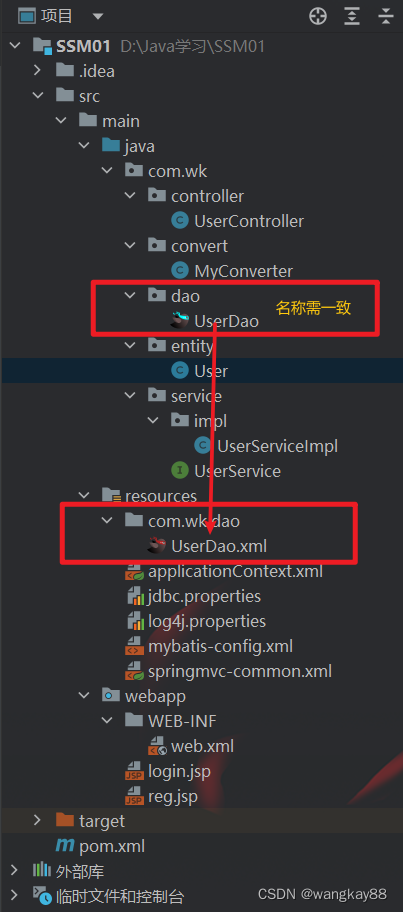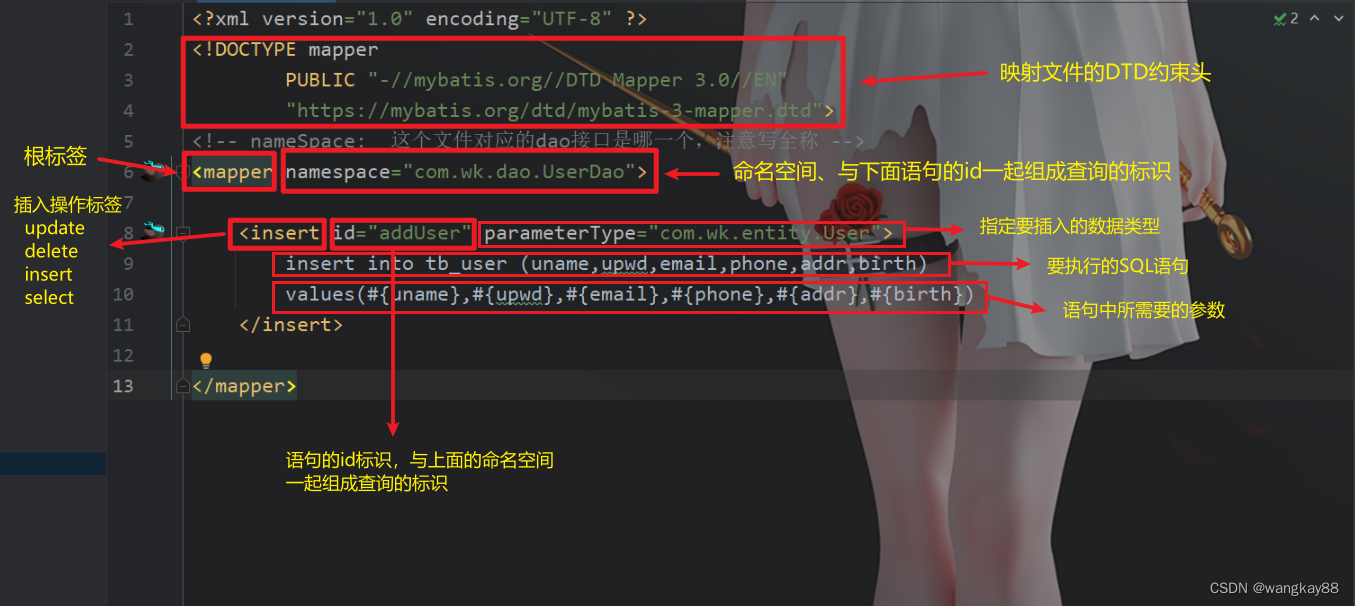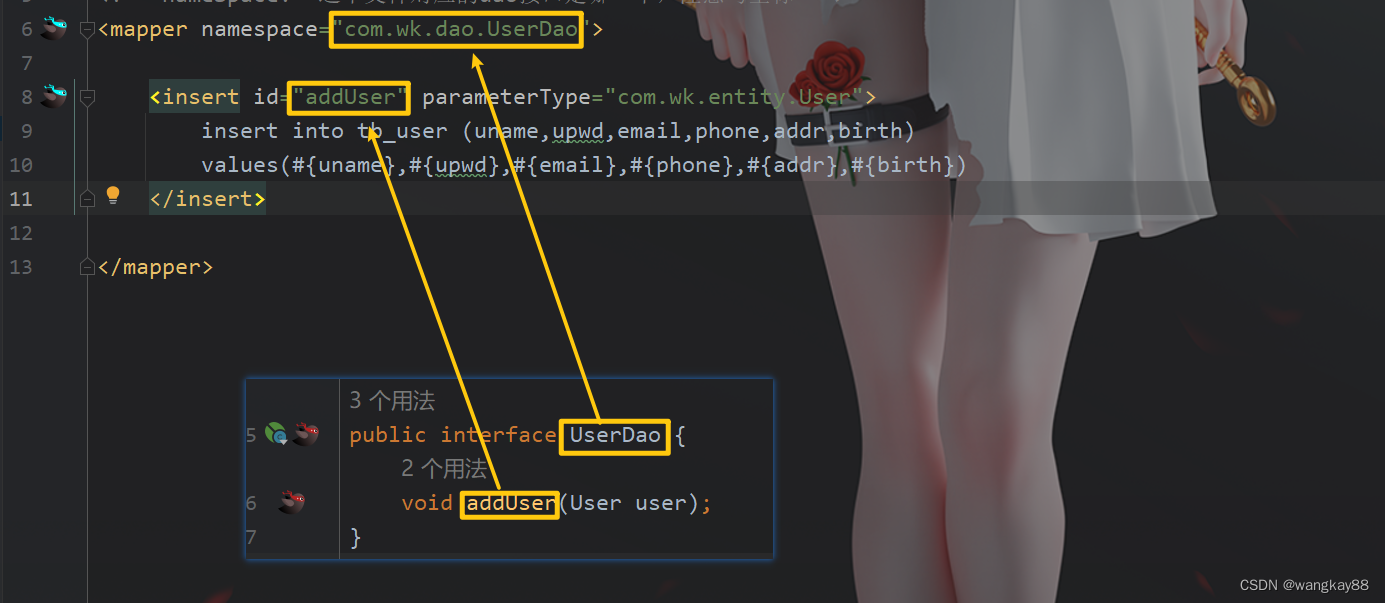Mybatis
原始jdbc操作的分析
原始jdbc开发存在的问题如下:
- 数据库连接创建、释放频繁造成系统资源浪费从而影响系统性能
- sql语句在代码中硬编码,造成代码不易维护,实际应用sql变化的可能较大,sql变动需要改变java代码。
- 查询操作时,需要手动将结果集中的数据手动封装到实体中。插入操作时,需要手动将实体的数据设置到sql语句的占位符位置
应对上述问题给出的解决方案:
- 使用数据库连接池初始化连接资源
- 将sql语句抽取到xml配置文件中
- 使用反射、内省等底层技术,自动将实体与表进行属性与字段的自动映射
一、简介
MyBatis官网
MyBatis开发步骤:
- 添加MyBatis的坐标
- 创建user数据表
- 编写User实体类
- 编写映射文件UserMapper.xml
- 编写核心文件SqlMapConfig.xml
- 编写测试类
二、环境搭建及案例
1. 导入MyBatis的坐标和其他相关坐标
<!--mybatis坐标--><dependency><groupId>org.mybatis</groupId><artifactId>mybatis</artifactId><version>3.4.5</version></dependency><!--mysql驱动坐标--><dependency><groupId>mysql</groupId><artifactId>mysql-connector-java</artifactId><version>5.1.6</version><scope>runtime</scope></dependency><!--单元测试坐标--><dependency><groupId>junit</groupId><artifactId>junit</artifactId><version>4.12</version><scope>test</scope></dependency><!--日志坐标--><dependency><groupId>log4j</groupId><artifactId>log4j</artifactId><version>1.2.12</version></dependency>
2、创建user数据表及编写实体类
privateInteger id;privateString uname;privateString upwd;privateString email;privateString phone;privateString addr;privateDate birth;
3、 编写UserDao映射文件

<?xml version="1.0" encoding="UTF-8" ?><!DOCTYPEmapperPUBLIC"-//mybatis.org//DTD Mapper 3.0//EN""https://mybatis.org/dtd/mybatis-3-mapper.dtd"><!-- nameSpace: 这个文件对应的dao接口是哪一个,注意写全称 --><mappernamespace="com.wk.dao.UserDao"><insertid="addUser"parameterType="com.wk.entity.User">
insert into tb_user (uname,upwd,email,phone,addr,birth)
values(#{uname},#{upwd},#{email},#{phone},#{addr},#{birth})
</insert></mapper>

插入操作注意问题
- 插入语句使用insert标签
- 在映射文件中使用parameterType属性指定要插入的数据类型
- Sql语句中使用#{实体属性名}方式引用实体中的属性值
- 插入操作使用的API是sqlSession.insert(“命名空间.id”,实体对象);
- 插入操作涉及数据库数据变化,所以要使用sqlSession对象显示的提交事务,即sqlSession.commit()
修改操作注意的问题
- 修改语句使用update标签
- 修改操作使用的API是sqlSession.update(“命名空间.id”,实体对象);
删除操作注意问题
- 删除语句使用delete标签
- Sql语句中使用#{任意字符串}方式引用传递的单个参数
- 删除操作使用的API是sqlSession.delete(“命名空间.id”,Object);
三、Mybatis的Dao层实现(代理开发方式)
1、代理开发方式简介(主流)
Mapper 接口开发方法只需要程序员编写Mapper 接口(相当于Dao 接口),由Mybatis 框架根据接口定义创建接口的动态代理对象,代理对象的方法体同上边Dao接口实现类方法。
Mapper 接口开发需要遵循以下规范:
- 1、 Mapper.xml文件中的namespace与mapper接口的全限定名相同
- 2、 Mapper接口方法名和Mapper.xml中定义的每个statement的id相同
- 3、 Mapper接口方法的输入参数类型和mapper.xml中定义的每个sql的- parameterType的类型相同
- 4、 Mapper接口方法的输出参数类型和mapper.xml中定义的每个sql的resultType的类型相同

四、动态SQL语句
1、
<if>
我们根据实体类的不同取值,使用不同的 SQL语句来进行查询。比如在 id如果不为空时可以根据id查询,如果username 不同空时还要加入用户名作为条件。
<selectid="findByCondition"parameterType="user"resultType="user">
select * from User
<where><iftest="id!=0">
and id=#{id}
</if><iftest="username!=null">
and username=#{username}
</if></where></select>
2、
<foreach>
标签用于遍历集合,它的属性:
- collection:代表要遍历的集合元素,注意编写时不要写#{}
- open:代表语句的开始部分
- close:代表结束部分
- item:代表遍历集合的每个元素,生成的变量名
- sperator:代表分隔符
<selectid="findByid"parameterType="list"resultMap="user">
select * from user
<where><foreachcollection="list"open="id in("close=")"item="id"separator=",">
#{id}
</foreach></where></select>
3、SQL片段抽取
<!--抽取sql片段简化编写-->
<sql id="selectUser" select * from User</sql><selectid="findById"parameterType="int"resultType="user"><includerefid="selectUser"></include> where id=#{id}
</select><selectid="findByIds"parameterType="list"resultType="user"><includerefid="selectUser"></include><where><foreachcollection="array"open="id in("close=")"item="id"separator=",">
#{id}
</foreach></where></select>
五、 typeHandlers标签
你可以重写类型处理器或创建你自己的类型处理器来处理不支持的或非标准的类型。具体做法为:实现org.apache.ibatis.type.TypeHandler 接口, 或继承一个很便利的类 org.apache.ibatis.type.BaseTypeHandler, 然后可以选择性地将它映射到一个JDBC类型。
例如需求:一个Java中的Date数据类型,我想将之存到数据库的时候存成一个1970年至今的毫秒数,取出来时转换成java的Date,即java的Date与数据库的varchar毫秒值之间转换。
开发步骤:
- 定义转换类继承类BaseTypeHandler
- 覆盖4个未实现的方法,其中setNonNullParameter为java程序设置数据到数据库的回调方法,getNullableResult为查询时 mysql的字符串类型转换成 java的Type类型的方法
- 在MyBatis核心配置文件中进行注册
- 测试转换是否正确
publicclassMyDateTypeHandlerextendsBaseTypeHandler<Date>{publicvoidsetNonNullParameter(PreparedStatement preparedStatement,int i,Date date,JdbcType type){
preparedStatement.setString(i,date.getTime()+"");}publicDategetNullableResult(ResultSet resultSet,String s)throwsSQLException{returnnewDate(resultSet.getLong(s));}publicDategetNullableResult(ResultSet resultSet,int i)throwsSQLException{returnnewDate(resultSet.getLong(i));}publicDategetNullableResult(CallableStatement callableStatement,int i)throwsSQLException{return callableStatement.getDate(i);}}
<!--注册类型自定义转换器--><typeHandlers><typeHandlerhandler="com.itheima.typeHandlers.MyDateTypeHandler"></typeHandler></typeHandlers>
六、plugins标签
MyBatis可以使用第三方的插件来对功能进行扩展,分页助手PageHelper是将分页的复杂操作进行封装,使用简单的方式即可获得分页的相关数据
开发步骤:
- 导入通用PageHelper的坐标
- 在mybatis核心配置文件中配置PageHelper插件
- 测试分页数据获取
1、导入通用PageHelper坐标
<!-- 分页助手 --><dependency><groupId>com.github.pagehelper</groupId><artifactId>pagehelper</artifactId><version>3.7.5</version></dependency><dependency><groupId>com.github.jsqlparser</groupId><artifactId>jsqlparser</artifactId><version>0.9.1</version></dependency>
2、在mybatis核心配置文件中配置PageHelper插件
<!-- 注意:分页助手的插件 配置在通用馆mapper之前 --><plugininterceptor="com.github.pagehelper.PageHelper"><!-- 指定方言 --><propertyname="dialect"value="mysql"/></plugin>
简答题
Mybatis中mapper文件一般用什么符号表示参数 #
用
$
也可以表示
但是用
$
表示存在SQL注入的风险,
$
底层是Statement来处理SQL语句 直接拼成一条字符串
而
#
么有SQL注入风险,
#
底层是preparestatement来处理SQL语句的;通过占位符
?
来处理
MyBatis核心配置文件常用标签:
- 1、properties标签:该标签可以加载外部的properties文件
- 2、typeAliases标签:设置类型别名
- 3、environments标签:数据源环境配置标签
- 4、typeHandlers标签:配置自定义类型处理器
- 5、plugins标签:配置MyBatis的插件
版权归原作者 wangkay88 所有, 如有侵权,请联系我们删除。